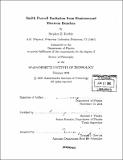| dc.contributor.advisor | Richard J. Temkin. | en_US |
| dc.contributor.author | Korbly, Stephen E | en_US |
| dc.contributor.other | Massachusetts Institute of Technology. Dept. of Physics. | en_US |
| dc.date.accessioned | 2008-03-26T20:32:57Z | |
| dc.date.available | 2008-03-26T20:32:57Z | |
| dc.date.copyright | 2005 | en_US |
| dc.date.issued | 2005 | en_US |
| dc.identifier.uri | http://dspace.mit.edu/handle/1721.1/32419 | en_US |
| dc.identifier.uri | http://hdl.handle.net/1721.1/32419 | |
| dc.description | Thesis (Ph. D.)--Massachusetts Institute of Technology, Dept. of Physics, 2005. | en_US |
| dc.description | Includes bibliographical references (p. 125-131). | en_US |
| dc.description.abstract | We present theoretical and experimental results from a Smith-Purcell radiation experiment using the electron beam from a 17 GHz high gradient accelerator. Smith- Purcell radiation occurs when a charged particle travels above a periodic grating structure. The electron beam consists of a train of 15 MeV, 9 pC bunches of bunch lengths varying from 600 fs to 1 ps. The radiated energy for one electron travelling above a periodic grating is solved. The effects of multiple electrons in a bunch and multiple bunches in a train are introduced. The Smith-Purcell resonance condition and the dependence of the radiated energy upon beam current and beam height above the grating are presented. Measurement of the angular distribution of the Smith- Purcell radiation resulted in bunch length measurements of 0.60 ± 0.1 ps and 1 ± 0.1 ps under different accelerator operating conditions. This demonstrates the use of Smith-Purcell radiation as a non-destructive bunch length diagnostic with 100 fs resolution. Smith-Purcell radiation is comparable to other sources of radiation, such as transistion radiation, synchrotron radiation, etc. except that it has an inherent enhancement by a factor of Ng, the number of grating periods. Additional enhancement occurs when the electron bunch length is short compared with the radiation wavelength, resulting in coherent emission with an enhancement by a factor of Ne the number of electrons in the bunch. Finally, the electron beam consists of a regular train of Nb bunches, resulting in an energy density spectrum that is restricted in frequency space to harmonics of the bunch train frequency, with an increase in the energy density at these frequencies by a factor of Nb. | en_US |
| dc.description.abstract | (cont.) We report the first observation of Smith-Purcell radiation displaying all three of these enhancements, that is, with a total enhancement of Ng.Ne.Nb. This total enhancement provides a simple method of generating powerful THz radiation at specific frequencies, which can be detected with a high signal to noise ratio by a heterodyne receiver. | en_US |
| dc.description.statementofresponsibility | by Stephen E. Krobly. | en_US |
| dc.format.extent | 131 p. | en_US |
| dc.language.iso | eng | en_US |
| dc.publisher | Massachusetts Institute of Technology | en_US |
| dc.rights | M.I.T. theses are protected by
copyright. They may be viewed from this source for any purpose, but
reproduction or distribution in any format is prohibited without written
permission. See provided URL for inquiries about permission. | en_US |
| dc.rights.uri | http://dspace.mit.edu/handle/1721.1/32419 | en_US |
| dc.rights.uri | http://dspace.mit.edu/handle/1721.1/7582 | en_US |
| dc.subject | Physics. | en_US |
| dc.title | Smith Purcell radiation from femtosecond electron bunches | en_US |
| dc.type | Thesis | en_US |
| dc.description.degree | Ph.D. | en_US |
| dc.contributor.department | Massachusetts Institute of Technology. Department of Physics | |
| dc.identifier.oclc | 61709122 | en_US |
